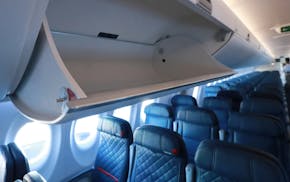Cleaner air has moved into northwestern Minnesota where air-quality alerts have been dropped, but the remainder of the state continues to be under advisories that are in effect until midday Wednesday.
A cold front combined with rain in parts of the state helped clean the air, and the trend will continue throughout Tuesday and into Wednesday as the worst air in four years moves out, said Ryan Lueck, an air-quality forecaster for the Minnesota Pollution Control Agency (MPCA).
The MPCA on Tuesday issued a rare hazardous warning for northwestern Minnesota due to thick concentrations of smoke from Canadian wildfires that filtered into the state.
The MPCA uses a color-coded scale when issuing alerts, with purple and maroon signaling when the air is the worst. On Tuesday, the agency issued a maroon warning for the northwest corner of the state and a purple warning for a large swath of northern and north-central Minnesota.
The agency has not issued a maroon warning since 2021, Lueck said.
"This is not common," said Lueck, noting the air quality has reached such poor levels only "a handful of times" over the past decade. "It's pretty rare."
From 2021 to present day, the MPCA has issued 19 alerts with a maximum AQI category of red or unhealthy, and one with a maximum AQI category of purple or very unhealthy.
While it is difficult to say for sure, Lueck said there is a reasonable chance Minnesota will see more severe alerts this summer. Wildfires in Canada generally peak in July and August as summer heat dries out vegetation. As of Tuesday, more than 200 wildfires were burning, including 74 in British Columbia, 55 in Alberta, 17 in Saskatchewan and 26 in Manitoba, according to the Canadian Interagency Forest Fire Centre.
With Minnesota downwind from those fires, "it is only a matter of time before a change in the wind pattern brings more smoke into Minnesota," Lueck said. "With more fires, there is a better chance we will be impacted by smoke."
The long-range forecast calls for warmer than normal conditions across Canada during June, July and August, the Weather Network said. While there may be some storms on the northern side of a heat dome that could develop over the central United States and southern Canadian provinces, "the rain is not expected to be widespread enough to mitigate the threat of wildfires," the station said.
In the short term, Minnesota looks to be nearly smoke free from Wednesday afternoon through Friday with no air-quality alerts in place, the MPCA said.
For the rest of Tuesday and into Wednesday morning, northeastern, central, south central, southeastern Minnesota and the Twin Cities area, a red alert for "unhealthy" air remained in effect.
At 7 a.m. Tuesday in Minneapolis, the air-quality index was at 263, or "very unhealthy," according to the U.S. Environmental Protection Agency's airnow.gov website. By noon, that number had dropped to 182.
A cold front moving across the state was helping to slowly push the haze and dirty air out of Minnesota. But the precipitation that came with it was only expected to offer limited relief, the MPCA said.
The rain "has the potential to help clean the air, but is not expected to all-together eliminate poor air quality," the MPCA said.
Air quality statewide is expected to improve on Wednesday, Lueck said. "Things will be better tomorrow."
By Wednesday, only the northeastern counties will be under an orange advisory, with the remainder of the state experiencing cleaner air, the MPCA said.
The MPCA advises residents to take precautions:
- Everyone should limit outdoor activities, especially in areas with red or maroon levels.
- Sensitive groups — including children, the elderly, pregnant individuals and those with respiratory or heart conditions — should avoid prolonged or vigorous outdoor activities in all affected areas.
- Use air purifiers indoors and keep windows closed to minimize smoke infiltration.
- Monitor local air-quality updates.
Residents are advised to stay informed and take necessary precautions to protect their health during this period of poor air quality.

Their faces covered during Minneapolis raid, federal agents raise privacy worries
Walz backs transgender kids in sports as Democrats grapple with debate over bans

Brother says Derrick Thompson was driving in crash that killed 5 Somali women

1st class passenger's violent outburst at MSP about overhead bin lands her in jail, charges say

